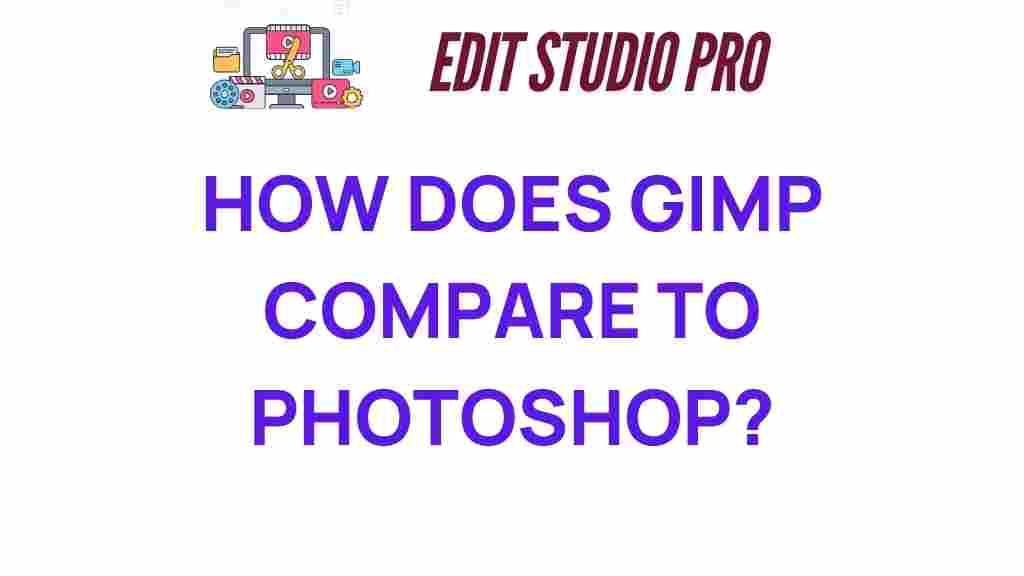GIMP vs. Photoshop: The Ultimate Showdown of Editing Power
In the world of photo editing and graphic design, two names consistently rise to the top: GIMP and Photoshop. Both are powerful tools that cater to different user needs, yet they come with their own strengths and weaknesses. This comprehensive comparison will delve into the features, user interface, affordability, and creative tools offered by both software, helping you make an informed choice for your photo editing projects.
Understanding GIMP and Photoshop
Before we dive deeper into the software comparison, let’s briefly introduce each tool:
- GIMP: The GNU Image Manipulation Program (GIMP) is an open-source photo editing software that is free to use. It is highly versatile and allows users to perform tasks such as photo retouching, image composition, and image authoring.
- Photoshop: Adobe Photoshop is a subscription-based software that is widely regarded as the industry standard for photo editing. It offers a robust set of features and tools that cater to professional photographers and graphic designers alike.
Key Features Comparison
When comparing GIMP and Photoshop, it’s essential to look at their features side by side. Here’s a breakdown of what each software offers:
User Interface
The user interface (UI) of photo editing software plays a crucial role in how effectively users can navigate and utilize the tools at their disposal.
- GIMP: GIMP’s interface is customizable, allowing users to arrange the layout according to their preferences. However, new users may find it less intuitive compared to Photoshop.
- Photoshop: Photoshop features a user-friendly interface that is widely praised for its intuitive design. The organized menus and toolbars help users quickly find the functionality they need.
Editing Tools
Both GIMP and Photoshop come packed with powerful editing tools, but there are some distinct differences:
- GIMP: GIMP offers a variety of tools, including brushes, layers, and filters. Its support for plugins and scripts allows users to extend its functionality significantly.
- Photoshop: Photoshop provides an extensive array of tools such as advanced selection tools, healing brushes, and 3D design capabilities. The software is continuously updated with new features, ensuring users have access to the latest technology.
File Format Support
File format compatibility is crucial for any graphic design software.
- GIMP: GIMP supports a wide range of file formats, including its native format (XCF), JPEG, PNG, GIF, and TIFF.
- Photoshop: Photoshop also supports various formats, including PSD (Photoshop’s native format), JPEG, PNG, and more, making it easier to work with other Adobe products.
Creative Tools
When it comes to creative tools, both software packages have their unique offerings.
- GIMP: Offers a variety of plugins for additional creative effects and tools. Users can create scripts to automate repetitive tasks.
- Photoshop: Integrates seamlessly with other Adobe products such as Illustrator and Lightroom, enhancing its creative capabilities significantly.
Affordability: GIMP vs. Photoshop
One significant factor that influences user choice between GIMP and Photoshop is affordability.
- GIMP: As an open-source program, GIMP is completely free to download and use. This makes it an attractive option for beginners and those on a tight budget.
- Photoshop: Photoshop operates on a subscription model, with plans starting at around $20.99 per month. While it offers a wealth of features, the cost can be a barrier for some users.
Step-by-Step Editing Process
Let’s take a closer look at how you can perform a basic photo editing task using both GIMP and Photoshop.
Editing a Photo in GIMP
- Open GIMP and load your image by clicking on File > Open.
- Use the Crop Tool to select the area you want to keep.
- Adjust brightness and contrast by navigating to Colors > Brightness-Contrast.
- Apply a filter if desired by selecting Filters from the menu.
- Save your edited image by going to File > Export As and choosing your desired format.
Editing a Photo in Photoshop
- Open Photoshop and load your image by clicking on File > Open.
- Use the Crop Tool from the toolbar to select your desired area.
- Navigate to Image > Adjustments > Brightness/Contrast to make color adjustments.
- Explore the Filters menu to apply effects.
- Save your work by selecting File > Save As and choose your preferred format.
Troubleshooting Common Issues
While both GIMP and Photoshop are powerful, users may encounter issues. Here are some common problems and their solutions:
GIMP Troubleshooting
- Issue: GIMP is running slowly.
Solution: Check your system resources and consider closing other applications. - Issue: Plugins not working.
Solution: Ensure that the plugins are correctly installed and compatible with your version of GIMP.
Photoshop Troubleshooting
- Issue: Photoshop crashes on startup.
Solution: Reset preferences by holding Ctrl + Alt + Shift while launching Photoshop. - Issue: Tools not behaving as expected.
Solution: Check the tool options bar to ensure the correct settings are applied.
Conclusion
When it comes to photo editing, both GIMP and Photoshop offer robust functionalities that cater to different types of users. GIMP stands out for those seeking a free and customizable option, particularly for hobbyists and beginners. On the other hand, Photoshop remains the go-to choice for professionals who require advanced features and seamless integration with other Adobe products.
Ultimately, the choice between GIMP and Photoshop boils down to personal preference, budget, and specific editing needs. If you want to explore more about graphic design tools, check out this resource.
For further comparisons and insights into photo editing software, you can visit this website for additional information.
This article is in the category Software & Tools and created by EditStudioPro Team
